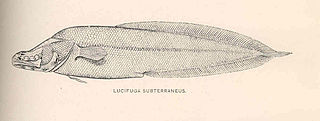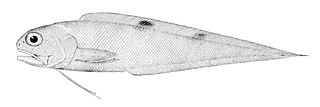Ophidiiformes is an order of ray-finned fish that includes the cusk-eels, pearlfishes, viviparous brotulas, and others. Members of this order have small heads and long slender bodies. They have either smooth scales or no scales, a long dorsal fin and an anal fin that typically runs into the caudal fin. They mostly come from the tropics and subtropics, and live in both freshwater and marine habitats, including abyssal depths. They have adopted a range of feeding methods and lifestyles, including parasitism. The majority are egg-laying, but some are viviparous.

The cusk-eel family, Ophidiidae, is a group of marine boney fishes in the order Ophidiiformes. The scientific name is from the Greek ophis meaning "snake", and refers to their eel-like appearance. True eels, however, diverged from other ray-finned fish during the Jurassic, while cusk-eels are part of the Percomorpha clade, along with tuna, perch, seahorses, and others. Unlike true eels of the order Anguilliformes, cusk-eels have ventral fins that are developed into a forked barbel-like organ below the mouth. In the true eels by contrast, the ventral fins are never well-developed and usually missing entirely.

Lucifuga is a genus of viviparous brotulas. Most of the species are native to caves and sinkholes in Cuba and the Bahamas; L. inopinata from deep water off the Galápagos Islands is the only exception. The four species rated by the IUCN are all considered vulnerable. The largest species in the genus reaches about 15 cm (5.9 in) in length.

Saccogaster is a genus of viviparous brotulas. They are found in the western Atlantic and Indo-Pacific.
Alionematichthys is a genus of viviparous brotulas.
Diplacanthopoma is a genus of viviparous brotulas.

Hephthocara is a small genus of Indo-Pacific viviparous brotula.
Alcockia is a genus in the cusk-eel family. It contains only the single species Alcockia rostrata, which is found in the Indian and western Pacific Oceans, at depths of from 2,761 to 4,040 metres. This species grows to a length of 35 centimetres (14 in) SL. The generic name Alcockia honours Alfred William Alcock (1859-1933) who was the surgeon-naturalist aboard the R.I.M.S. Investigator.
Bassozetus is a genus of cusk-eels found in Atlantic, Indian and Pacific Ocean.
Dicrolene is a genus of cusk-eels.
Glyptophidium is a genus of cusk-eels.

Holcomycteronus is a genus of cusk-eels. It includes Holcomycteronus profundissimus, long thought to be the deepest-living fish in the world's oceans.
Hoplobrotula is a genus of cusk-eels.

Lepophidium is a genus of cusk-eels.

Monomitopus is a genus of cusk-eels. They are oviparous.

Neobythites is a genus of cusk-eels.

Ophidion is a genus of cusk-eels.

Otophidium is a genus of cusk-eels, part of the subfamily Ophidiinae in the family Ophidiidae. They are found in the western Atlantic and eastern Pacific.
Porogadus is a genus of cusk-eels.

Pycnocraspedum is a genus of cusk-eels.











